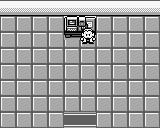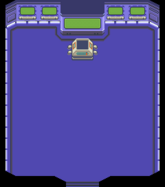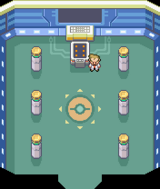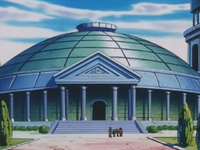Hall of Fame
- For the books, see Pokémon: Sinnoh Hall of Fame and Pokémon Hall of Fame (book).
The Hall of Fame (Japanese: 殿堂入り Induction to the Hall of Fame) is a record kept by the Pokémon League of all the Pokémon Trainers who have ever beaten the Elite Four and the Pokémon Champion. Various data regarding the victorious Trainer is recorded. The Hall of Fame is in a room accessible from the Champion's room, and may be accessed by people who have entered it by way of PC.

Data recorded
In each game, data is recorded into the PC, which is also shown during the games' ending scene. This is a list of which data is visible on the Hall of Fame PC option.
Generation I
Hall of Fame records are stored per individual Pokémon. This means that a single member team is given a single record, while a six-member team is given six records. Each uniquely indexed record holds the Pokémon's species, level and nickname. The Pokémon's type is also displayed, however this value is generated from the record's species index itself.
All Generation I games store the player's 50 most recent records in ascending order. Any further records overwrite the oldest record present. For example, if a player were to defeat the Elite Four 51 times, feats 2 through 51 would be displayed in that order, with 1 having been overwritten. This storage allows for a maximum of 300 Pokémon records to be displayed in the Hall of Fame at any given time.
In addition, the player's name, playing time, money, sprite, and number of Pokémon obtained are displayed during the ending scene, along with each team member's unique record beforehand. Professor Oak also evaluates the player's Pokédex before the credits roll.
Generation II
Hall of Fame records are again stored per individual Pokémon. Each uniquely indexed record now holds the Pokémon's species, level, IVs, Trainer ID number and nickname. Although the IVs are not visible, they are used to display the Pokémon's gender, alternate color, and Unown form, if any of the three apply to the given specimen. The Pokémon's index number is also displayed, however this value is generated from the record's species index itself.
All Generation II games store the player's 30 most previous feats in a descending order. Any further feats would again delete records in a First In, First Out method. For example, if a player were to defeat the Elite Four 31 times, feats 31 through 2 would be displayed in that order, with 1 having been overwritten. This storage allows for a maximum of 180 Pokémon records to be displayed in the Hall of Fame at any given time.
In addition, the player's name, Trainer ID number, playing time, sprite, and number of Pokémon obtained are displayed during the ending scene, along with each team member's unique record beforehand. Professor Oak also evaluates the player's Pokédex before the credits roll.
Generation III
Hall of Fame records are now stored per each team, so as to save time traversing through records. This means that a single member team is given a single record, while a six-member is team is also given a single record. Each indexed record holds an entire team's data, with each unique team member entry consisting of its species, level, nickname, personality value, and Trainer ID number. Personality values work exactly like IVs in Generation II, in that they are not visible, yet are used to display the Pokémon's gender, alternate color, and Unown and/or Spinda form, if any of the three apply to the given specimen. The Pokémon's index number is once again displayed, however this value is generated from the record's species index itself.
All Generation III games store the player's 50 most previous feats in a descending order. Any further feats would delete records in a First In, First Out method. For example, if a player were to defeat the Elite Four 51 times, feats 51 through 2 would be displayed in that order, with 1 having been overwritten. This storage allows for a maximum of 50 team records, each with a maximum of 300 Pokémon total, to be displayed in the Hall of Fame at any given time.
In addition, the player's name, Trainer ID number, playing time and sprite are displayed during the ending scene, along with each team member's unique record beforehand. Unlike previous generations, however; each game's regional Professor will not evaluate the Pokédex. Instead, the message LEAGUE CHAMPION! CONGRATULATIONS! is displayed before the credits roll.
Generation IV
Hall of Fame records are again stored per each team, so as to save time traversing through records. Each indexed record holds the date the feat took place, as well as an entire team's data, with each unique team member entry consisting of its species, level, nickname, personality value, Trainer name and all four learned moves. Personality values are not visible, yet are used to display the Pokémon's gender, alternate color, and form, if any of the three apply to the given specimen.
All Generation IV games store the player's 30 most previous feats in a descending order. Any further feats would delete records in a First In, First Out method. For example, if a player were to defeat the Elite Four 31 times, feats 31 through 2 would be displayed in that order, with 1 having been overwritten. This storage allows for a maximum of 30 team records, each with a maximum of 180 Pokémon total, to be displayed in the Hall of Fame at any given time.
In addition, the player's name, Trainer ID number, playing time and sprite and the message League Champion! Congratulations! are displayed during the ending scene, along with each team member's unique record beforehand.
Additionally, when a team member is displayed during the ending scene, its original catching location will be displayed. Whether this piece of information is stored within each team member's Hall of Fame record or not has yet to be researched.
Generation V

|
This section is incomplete. Please feel free to edit this section to add missing information and complete it. Reason: Needs research on how the Hall of Fame data is stored |
In addition to recording the player's party after defeating the Champion in all games of Generation V, the Hall of Fame in Pokémon Black and White also records data after the player defeats Ghetsis. A maximum of 15 entries can be recorded at any time, as well as the First Game Clear. The data is again deleted using the First In, First Out method. The data is stored in the "Records" section of the PC. Each entry includes the date the player entered the Hall of Fame, their Pokémon's nickname, gender, level, species, Original Trainer, and moves.
Generation VI
After defeating the Elite Four, the player's party is saved in the Hall of Fame. Stored data for each party member includes species, gender, level, nickname, Original Trainer, moves, and held items. Similarly to Generation V, a maximum of 15 Elite Four clears can be recorded at any time, as well as the First Game Clear. The data is deleted using the First In, First Out method.
Rewards

|
This section is incomplete. Please feel free to edit this section to add missing information and complete it. Reason: ORAS |
- In Generation I, the player is granted access to Cerulean Cave, while in Pokémon FireRed and LeafGreen, the Generation III remakes of Pokémon Red and Green, it is one of the requirements needed to enter Cerulean Cave.
- In Generation II and Pokémon HeartGold and SoulSilver, the player is given a S.S. Ticket for the S.S. Aqua, effectively giving them access to the Kanto region.
- In the Hoenn-based Generation III games and Sinnoh-based Generation IV games, players are rewarded the following for entering the Hall of Fame:
- In Pokémon Ruby, Sapphire, and Emerald and Pokémon Diamond, Pearl, and Platinum, a star will be placed on the player's Trainer Card, changing its color.
- In Pokémon Ruby, Sapphire, and Emerald, a Champion Ribbon will be given to all of the player's Pokémon that get into the Hall of Fame. In Pokémon Diamond, Pearl, and Platinum, a Sinnoh Champ Ribbon will be given to all of the player's Pokémon that get into the Hall of Fame.
- In Pokémon Diamond and Pearl, the rival's team at the Fight Area will be ten levels higher once the player enters the Hall of Fame twenty times. In Pokémon Platinum, under the same conditions, the rival's team at the Survival Area will be twenty levels higher.
- In Pokémon Black and White, the player receives additional PC wallpapers to commemorate the conquest of the Unova Elite Four and Team Plasma, and another set for defeating the Elite Four in rematches and the first defeat of Alder. In Pokémon Black 2 and White 2, one set of wallpapers is unlocked upon defeating Iris and the other upon capturing Kyurem.
- In Pokémon Black 2 and White 2 the player is allowed to go back to the Giant Chasm to catch Kyurem and obtain the DNA Splicers.
- In X and Y, the player is granted access to the Unknown Dungeon where Mewtwo can be captured, along with its respective Mega Stone. Zygarde and Moltres, Zapdos, or Articuno, depending on the starter chosen at the start of the game, are also available for capture. Outside the player's house, Shauna will offer to trade any of the player's Pokémon for the unevolved form of her starter Pokémon, and upon reaching the Lumiose City train station, access to Kiloude City, and by extension, the Battle Maison, Friend Safari, and rematches with the rival, will be granted. Finally, after completing certain conditions, the player's Mega Ring can be upgraded, and a sidequest involving Looker can be initiated in Lumiose City.
- In Omega Ruby and Alpha Sapphire, after the first time, the Delta Episode starts, and Birch gives the player a Johto starter. The second time, the player is given a Sinnoh starter.
Layout

|
This section is incomplete. Please feel free to edit this section to add missing information and complete it. Reason: Missing all layouts from generation V and VI |
Generations I-III
| Red | Blue | Yellow | Gold | Silver | Crystal | Ruby | Sapphire | Emerald | FireRed | LeafGreen |
|---|---|---|---|---|---|---|---|---|---|---|

|

|

|

| |||||||
Generation IV onward
| Diamond | Pearl | Platinum | HeartGold | SoulSilver |
|---|---|---|---|---|

| ||||
Glitches
- In the Generation I games, if the player encounters MissingNo. or other glitch Pokémon, the Hall of Fame data may be corrupted by a glitch in the game. When MissingNo. has been seen on the save file, the player's Hall of Fame is badly corrupted with entirely different Pokémon, which will often consist of glitched characters and names. Players can often see particular Pokémon in the Hall of Fame, whether they have seen them in the Pokédex or not. This effect also works in Pokémon Yellow when encountering glitch Pokémon through the Mew glitch. However, a way to avoid the effects of this glitch is to encounter MissingNo. or any other glitch Pokémon before entering the Hall of Fame, because encountering a MissingNo. only affects the teams already registered in the Hall of Fame. Players can also defeat the Elite Four multiple times after having encountered MissingNo., as the game will automatically overwrite older Hall of Fame entries after the Elite Four is defeated 20 times.
- In Pokémon Red and Green, performing the Dokokashira door glitch allows the player to quickly complete the game by forcing the next door to take them to another location; this can include the Hall of Fame room. This extremely hazardous and game-breaking glitch was removed from Pokémon Blue, causing it to not be present in the translated Pokémon Red and Blue.
- In earlier versions of Pokémon Omega Ruby and Alpha Sapphire, the game would sometimes freeze after recording the player's team data in the Hall of Fame; this glitch was patched out in the Version 1.2 update on December 3, 2014, 12 days after the games' initial release.
In the anime
In the main series
The Hall of Fame's only appearance in the anime was in Enter the Dragonite. After beating Drake, the Head Leader of the Orange League, Ash earned a spot in the Palace of Victory, which is also known as the Orange League Hall of Fame. A photo of the winning Trainers and their Pokémon are kept on display.
In Pokémon Origins
The Hall of Fame appeared in the Pokémon Origins episode File 4: Charizard after Red defeated Blue and became the Pokémon League Champion. Much like in the games, Red was led to the Hall of Fame by Professor Oak, after which Red's Pokémon's data was recorded and displayed on a screen. The Hall of Fame contained numerous portraits of all the previous Champions and their Pokémon teams.
Trivia
- The "Congratulations" screen in the Generation V games shows the player with one of their Pokémon; After showing one battle animation cycle, it rotates the Pokémon off-screen to the left and the next Pokémon takes its place from the right. This is similar to what occurs in the title screen of Pokémon Red, Green, and Blue.
In other languages
| ||||||||||||||||||||||||||||||||

|
The Pokémon League | 
| |
|---|---|---|---|
| Participation Trainer • Battle • Gym Leaders Gyms • Badges • Referee Championship matches Elite Four • Orange League Champion League Pokémon League Conferences Indigo • Silver • Ever Grande • Lily of the Valley Vertress • Lumiose • Manalo |
Regional Pokémon Leagues Indigo • Orange* • Johto • Hoenn • Sinnoh Unova (BB) • Kalos • Alola • Galar • Paldea Areas of jurisdiction Pokémon League Reception Gate • Hall of Fame Palace of Victory • Cerulean Cave • Area Zero Others Admissions Exam • Pokémon Association PIA • World Coronation Series (Masters Eight Tournament) | ||

|
This article is part of Project Locations, a Bulbapedia project that aims to write comprehensive articles on every location in the Pokémon world. |



